Know the Rules of Your 401(k)
There are all sorts of regulations controlling how money goes in and comes out of a 401(k). Knowing them is crucial.

Because the 401(k) is such a sweet tax shelter, there are all sorts of regulations controlling how money goes in and comes out.
Knowing as much as you can about the plan you are in — or the plan of a company you may be considering — is crucial.
Here's a roundup of the rules:

Sign up for Kiplinger’s Free E-Newsletters
Profit and prosper with the best of expert advice on investing, taxes, retirement, personal finance and more - straight to your e-mail.
Profit and prosper with the best of expert advice - straight to your e-mail.
Eligibility. Although companies can require you to wait for up to one year to join, most don't.
Employee contributions. In 2015, most employees can contribute up to $18,000 to their 401(k) plan, 403(b) plan, federal Thrift Savings Plan or most 457 plans. Some highly compensated workers who earn $120,000 or more may not be able to contribute the full amount if not enough lower-paid employees participate in the retirement plan. And there's a catch-up provision in case you're nearing retirement and haven't accumulated a large enough nest egg. Those 50 and older can shovel in an extra $6,000. Even highly compensated employees whose contributions are restricted can make catch-up contributions if their plan allows it.
Matching contributions. These are made at the discretion of the company. Total employee and employer contributions are limited to the lesser of 100% of salary or $53,000 in 2015, plus catch-up contributions for workers 50 and older. A typical employer match is 50 cents or $1 for every $1 the employee contributes, up to the first 6% of pay.
There is no rule of thumb for when the match is applied. It may be every pay period, every quarter or even on the last day of the year. Knowing when your company makes its matching contributions could be a factor if you are thinking about switching jobs. You don't want to leave just before the match is made.
Vesting. Your own contributions are immediately "vested," meaning they are yours to keep if you leave the company. Company contributions can vest immediately or over a period as long as six years.
Loans. Allowed by most plans (see Borrowing From a 401(k) Can Lead to Trouble).
Early withdrawal. No withdrawals (except hardship withdrawals) are allowed before age 59½ while you are employed. If you leave the company before age 55, withdrawals are taxed and generally hit with a 10% penalty, unless they're rolled over into an IRA or another employer's 401(k).
Hardship withdrawal. A plan may allow early withdrawal of your contributions if you face financial hardship and can show you have no other source for cash. Such withdrawals are taxed and penalized if you're under 59½.
Cashing out. Upon leaving the company, you can transfer your balance tax-free to an IRA. Distributions not rolled over are taxed as ordinary income, in your top tax bracket (except to the extent you made after-tax contributions). Employers now are required to roll over 401(k) balances between $1,000 and $5,000 into an IRA for you. Accounts with less than $1,000 will be automatically cashed out — and fall subject to taxes and penalties. Departing employees with accounts worth more than $5,000 will have the option of leaving their money in their former employer's 401(k) plan.
Company stock. Special rules may make it beneficial to withdraw company stock rather than rolling it into an IRA. The stock is taxed at its value when it went into the plan; appreciation — both inside the plan and after withdrawal — will be taxed as capital gains when you sell the stock.
Mandatory withdrawals. You must begin to draw down your 401(k) by April 1 of the year after you turn 70½ or when you retire, whichever is later.
Locked out of a new employer's plan? Do a little payroll deducting on your own, saving the money in a taxable account until the doors of the 401(k) open. Then double up your contributions for a while, using the money you set aside to make up for the shortfall in your paycheck.
Get Kiplinger Today newsletter — free
Profit and prosper with the best of Kiplinger's advice on investing, taxes, retirement, personal finance and much more. Delivered daily. Enter your email in the box and click Sign Me Up.
-
 Amazon Haul Online Is Here – Shop Under $20 Deals Without the App
Amazon Haul Online Is Here – Shop Under $20 Deals Without the AppThe Amazon storefront where everything costs $20 or less is now available online.
By Rachael Green Published
-
 Lowe's Stores Closing All Locations for 24 Hours: When and Why
Lowe's Stores Closing All Locations for 24 Hours: When and WhyLowe's will close all of its retail locations and contact center for one day in April.
By Sean Jackson Published
-
 What DOGE is Doing Now
What DOGE is Doing NowThe Kiplinger Letter As Musk's DOGE pursues its ambitious agenda, uncertainty and legal challenges are mounting — causing frustration for Trump.
By Matthew Housiaux Published
-
 COVID Hospitalization Rates See an Uptick As Winter Looms — The Kiplinger Letter
COVID Hospitalization Rates See an Uptick As Winter Looms — The Kiplinger LetterThe Kiplinger Letter A new Omicron booster is available, but the elderly are still at risk and winter is right around the corner.
By David Payne Published
-
 Will Weight-Loss Drugs Spike Medicare Costs?: The Kiplinger Letter
Will Weight-Loss Drugs Spike Medicare Costs?: The Kiplinger LetterEconomic Forecasts Lawmakers are trying to get weight-loss drugs like Wegovy covered by Medicare. Long-term savings are possible, but it could cost the program $27 billion.
By John Miley Published
-
 Greenland, U.S. Plans to Boost Tourist Economy: Kiplinger Economic Forecasts
Greenland, U.S. Plans to Boost Tourist Economy: Kiplinger Economic ForecastsEconomic Forecasts A U.S. congressional effort could see some Canadian visitors get longer stays, meanwhile, Greenland bids to be the next vacation hotspot.
By Sean Lengell Published
-
 Medicare Drug Price Negotiations Latest: Kiplinger Economic Forecasts
Medicare Drug Price Negotiations Latest: Kiplinger Economic ForecastsEconomic Forecasts Medicare drug price negotiations: Early signs have emerged of how these key talks will be handled.
By Matthew Housiaux Published
-
 Understanding Capital Gains and Losses
Understanding Capital Gains and Lossescapital gains tax What's a capital asset, and how much tax do I have to pay when I sell?
By the editors of Kiplinger's Personal Finance Published
-
 Forces That Affect Your Estate Plan
Forces That Affect Your Estate Planretirement From probate and ownership division to the taxing arm of Uncle Sam, here are four things that can influence what happens to your belongings.
By the editors of Kiplinger's Personal Finance Published
-
 Make a Plan for Your Retirement Savings
Make a Plan for Your Retirement Savingsretirement The first step to effectively using your 401(k) is to assess your retirement needs.
By the editors of Kiplinger's Personal Finance Published